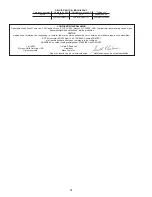
1
OPERATING
The lever is the on/off valve for the tool. Connect to a suitable
air supply and ensure the air pressure measured at the tool inlet
with the tool running does not exceed 90 PSIG (6.2 bar). Select
disc type and ensure that the disc is not cracked or damaged
and that the speed rating of the disc is in excess of 25,000
RPM. Using only the spacer (30) supplied with the tool, fit the
disc and tighten wheel screw (31) while holding nut (28). Do not
over tighten as this could crack the disc. Ensure wheel cover
(27) is in place. When first starting the tool with a new or changed
disc the tool should be first started in a protected area i.e. such
as under a heavy bench and run for a minimum time of one
minute. This will provide protection if the wheel should break
because a fault was not detected.
Always use eye protection and wear protective gloves. Remem-
ber that the cutting process will generate heat and that cut
parts, particularly small items, can get very hot and burn fingers
if touched. Allow cut parts to cool.
The tool and the work process may create a noise level such
that ear protectors should be worn. The cutting process will
create dust and the use of breathing masks is recommended.
Check that the material being cut will not cause harmful dust or
fumes. If this is so, then special breathing apparatus may be
required. Seek advice before starting work. The cutting process
will create sparks. Ensure that these do not create a hazard to
any person, object or process, and are not directed near any
flammable materials or fluids. Do not use the cutter in explosive
environments. Do not apply excessive loads to the tool as this
will reduce the efficiency of the disc. Apply light loads and allow
the wheel to cut. Try always to keep the disc square to the cut.
Do not apply side loads or grind on the side of the disc. Handle
the cutter with care. If the cutter is dropped, carefully examine
the disc for damage and replace if necessary. Start the tool as
for the first time of fitting a disc. i.e. under a bench. Make sure
that the object to be cut is in a firm, fixed position.
Printed In U.S.A.
Form ZCE577
Date 2003July23/C
Page 1 of 18
INSTRUCTIONS & PARTS LIST FOR 1957HP CUT-OFF TOOL
Read and understand "Safety Instructions For Air Tools" and these instructions before
operating this tool.
AIR SUPPLY
The efficiency of the tool is dependent on the proper supply of
clean dry air at 90 psig (6.2 bar). The use of a line filter, pres-
sure regulator, and lubricator will insure maximum output and
life of tools. Before connecting tool, blow out the air line to
remove water and dirt which may have accumulated.
HOSE AND HOSE CONNECTIONS
Supply hose should be not less than 3/8" (10mm) I.D. Exten-
sion hoses should be at least 1/2" (13mm) I.D. Use couplings
and fittings with at least 3/8" (10mm) I.D.
LUBRICATION
Use SIOUX No. 288 air motor oil. An airline lubricator, set to
deliver 2 to 3 drops per minute, is recommended. If a lubricator
is not used, add .08 oz. (2.4 cc, 24 to 30 drops) of oil into the
air inlet every 2 to 3 hours.
INSTRUCTIONS FOR CUT-OFF TOOLS
GENERAL OPERATION
• The tool is equipped with a lock-out type lever in order to
prevent accidental start-up.
• Speed of the tool may be adjusted by turning the speed
control, which is located under the lever.
• Never operate without guide in place.
• A wheel with any chips or cracks should be removed from
service and destroyed.
USE OF THE TOOL
This tool is designed to be used with flat reinforced resin 2 7/
8" diameter maximum discs having a speed rated above 25000
RPM. The bore size of the disc is 3/8".
The tool should not be used with any other type or rating of
abrasive disc or wheel. It must never be used with saw blades
or other cutting devices.
CHANGING WHEEL
1. Disconnect tool from air line.
2. Hold arbor stationary with an 11/16 (17.5 mm) wrench.
Remove screw retaining wheel with 3/16 (4.7 mm) allen
wrench.
3. Place new wheel on arbor, add flange with counterbore
towards wheel. Add screw and tighten.
Содержание 1957HP
Страница 17: ...17 NOTES ...


































